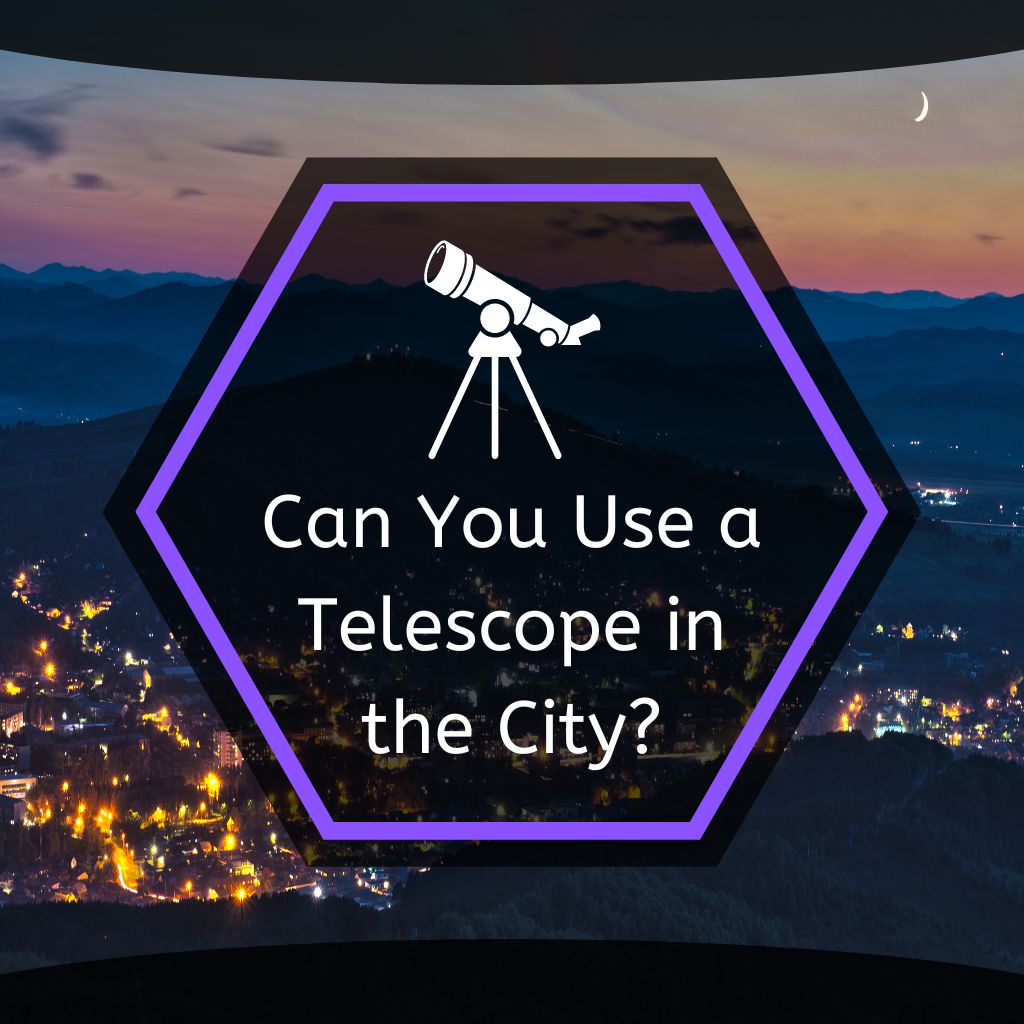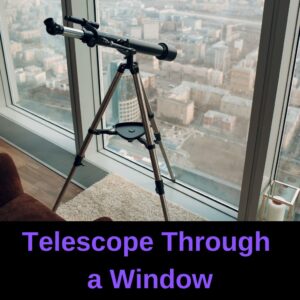This site contains affiliate links to products. I may receive a commission for purchases made through these links.
You can use a telescope in the city. While urban environments can present some challenges, such as light pollution and atmospheric disturbances, with the right equipment and techniques, it is possible to observe the wonders of the night sky in a city.
In this article, we’ll explore tips for using a telescope in the city. We’ll cover everything from selecting the right equipment and accessories to choosing the best observing locations and dealing with light pollution.
Do telescopes work in the city?
Telescopes work in the city, but light pollution can make it challenging to observe faint celestial objects. However, getting a great view of the stars, planets, and other celestial objects is still possible with the right equipment and techniques.
The dark skies indeed present the best views of celestial objects in a rural environment due to the absence of light pollution, but you can still view deep-sky objects in a city location.
Using a telescope in a city poses unique challenges for stargazing enthusiasts who want to use telescopes to explore the night sky.
Among the most significant obstacles is the prevalence of light pollution, which emanates from street lamps, brightly lit buildings, outdoor lights, and other sources, making it difficult to observe faint objects and see details.
However, this doesn’t mean that telescopes are useless in the city. With careful planning, the right equipment, and the use of specific techniques, you can still capture beautiful views of celestial objects.
What celestial objects are best viewed with a telescope in a city?
While light pollution can make it challenging to observe faint celestial objects in the city, there are still plenty of deep objects that are visible.
Some of the celestial objects you can observe with a telescope in the city are listed below.
The Moon
The Moon is the brightest object in the night sky, and its proximity to Earth makes it appear much larger than other celestial objects. Even with light pollution present in the city, the Moon can still be observed with great clarity due to its brightness.
This makes it a great target for amateur astronomers who want to explore the night sky. A standard telescope is sufficient for observing the Moon, allowing you to view its craters, mountains, and other features in great detail.
The craters on the Moon are especially fascinating to observe, and they provide insight into its geological history.
The telescope also lets you view the shadows the craters cast on the Moon’s surface during different phases, adding another layer of interest to your observation.
Planets
While the light pollution in cities can make it difficult to see all the planets in our solar system, some celestial objects still shine bright enough to be visible even with a small telescope. Venus, Mars, Saturn, and Jupiter are among the most striking targets for city astronomers.
Jupiter and its four largest moons are an awe-inspiring sight, visible even with a small telescope. The planet’s distinctive bands, featuring swirling gas and dust, make for a mesmerizing observation.
Meanwhile, Saturn’s iconic rings and its many moons offer a breathtaking view of the gas giant.
Mars stands out in the night sky with its distinct red hue. Its polar caps and other features can be easily seen with a small telescope, providing a fascinating look at the planet’s surface.
Venus is one of the brightest objects in the night sky, easily visible in both the evening and morning hours. Its striking appearance makes it a popular target for astronomers of all skill levels.
These planets are especially visible because of their proximity to Earth, making them ideal for observation even in urban areas.
Deep sky objects
Gazing up at the night sky, one may be surprised to discover that certain deep sky objects, such as globular and open clusters, can be discerned even amidst the visible light of the city, provided they are positioned near the zenith.
This is because a vast number of stars are densely packed into a relatively small area, resulting in a concentrated intensity of light that can effectively overpower the dimming effects of the urban atmosphere.
Among the array of mesmerizing deep sky objects that can be observed under such circumstances are M6 in Scorpius, the illustrious Hercules Cluster (M13), and the captivating Pleiades in Taurus.
Meanwhile, the dazzling planetary nebulas, such as the Orion Nebula, the Ring Nebula in Lyra, and the aptly named Dumbbell Nebula, are among the most striking sights that one can behold in the night sky.
Double and variable stars
Double and variable stars are highly visible in urban areas despite the bright city lights, thanks to their remarkable brightness. These celestial objects are captivating to observe due to their distinct colors and varying brightness levels.
Despite the light pollution in cities, they can be easily located in the night sky.
8 tips for using a telescope in the city to observe objects in the night sky
Observing the night sky in urban areas poses a distinctive set of difficulties, such as obstructive tall buildings, light pollution, and air pollution.
Nevertheless, you can still savor the enchanting experience of stargazing in the city with some useful pointers and techniques.
Here are some tips to help you get the most out of your telescope while observing the night sky in urban environments.
1. Choose the right telescope
Choosing the right telescope is crucial for anyone interested in observing celestial objects in the city.
Here are some factors to consider when selecting a telescope:
- Aperture: The aperture is the diameter of the telescope’s main mirror or lens. The larger the aperture, the more light the telescope can gather, resulting in brighter, sharper images. This is especially important in cities, where light pollution can obscure faint objects in the sky.
- Portability: If you plan on traveling to different locations to observe the night sky, consider a portable telescope that is easy to set up and transport.
You may also like: What Is a Good Aperture for a Telescope?
Best telescopes to use in a city
One of the best telescopes for use in the city is the Celestron NexStar Evolution 6. It is an excellent choice for a Schmidt-Cassegrain telescope, especially for city dwellers.
Equipped with a computerized mount, this telescope makes tracking celestial objects in the urban sky easier, where light pollution can be problematic.
The compact design of the Nextar Evolution 6 makes it portable and easy to set up in small spaces, making it an ideal option for apartment balconies or rooftops.
If you’re willing to invest more, the Celestron NexStar 8SE is an exceptional telescope offering advanced features. This makes it an excellent option for city dwellers who want to enjoy stargazing in their urban environment.
The larger aperture of the Celestron NexStar 8SE enables it to gather more light, which is especially important when viewing from a location with light pollution.
With its superior light-gathering ability, this telescope can reveal more detail and brightness in celestial objects, even in light-polluted areas.
Read also: Celestron NexStar 8SE Review (Planetary Telescope)
2. Choose the right location
Location is a critical factor in determining the quality of your stargazing experience in the city. Here are some tips on finding the best location for setting up your telescope in the city
- Avoid bright lights: Set up your telescope away from street lights, buildings, and other sources of light pollution that can affect visibility.
- Look for high elevation: Higher ground will offer better viewing conditions and less air pollution.
Best place to set up a telescope in a city
Here are some of the best places to set up your telescope in a city:
- City parks or open spaces: City parks or open spaces away from the city center can be excellent locations for setting up a telescope in the city. These areas tend to have less light pollution, making it easier to see celestial objects.
- Rooftops or balconies: This can be a great place to set up your telescope. It will allow you to get above street level and avoid the light pollution caused by buildings and streetlights. They also provide a stable platform for your telescope. However, it’s worth noting that rooftops can absorb heat during the day, which may impact your viewing experience.
- Backyards: If you have a backyard or a balcony, it can be a convenient and comfortable spot to observe the night sky.
3. Use filters
Filters can help enhance your viewing experience when observing celestial objects in the city. Here are some types of filters to consider:
- Light pollution filters: These filters are designed to block out specific wavelengths of light emitted by streetlights and other sources of light pollution.
- Solar filters: If you plan to observe the sun, a solar filter can protect your eyes and your telescope from damage caused by intense sunlight.
- Nebula filters: These filters enhance the contrast of faint nebulae by blocking out certain wavelengths of light.
A good light pollution filter for city viewing is the Celestron Light Pollution Reduction (LPR) Filter. This filter is designed to block out the specific wavelengths of light emitted by common outdoor lighting in cities, such as streetlights and building lights.
By blocking out this unwanted light, the filter helps to enhance the contrast and visibility of celestial objects being observed, such as stars, galaxies, and nebulae.
Read also:
- 16 Top-Rated Light Pollution Filters for Your Telescope
- How to Use Telescope Filters (Beginners Guide)
4. Use the right eyepieces
The right eyepiece can make all the difference in your stargazing experience in the city. Light pollution is a major issue when viewing from a city, so you’ll want an eyepiece with a wide field of view and a low magnification.
A wider field of view will allow you to see more of the night sky at once, and a lower magnification will help to brighten the image and reduce the effects of light pollution.
Additionally, you may want to consider an eyepiece with longer eye relief, as this will allow you to view the image comfortably even if you wear glasses.
Considering these factors, a good type of eyepiece for city viewing in a telescope would be a wide-angle eyepiece with a low magnification, such as a 25mm or 32mm eyepiece.
A popular option is the 32mm Plossl eyepiece, which provides a wide field of view and a bright image, making it ideal for city viewing.
You may also like: 5 Best Telescope Eyepieces for Viewing Planets
5. Use a Barlow lens
A Barlow lens is an excellent accessory to have for your telescope in the city. It can increase the magnification of your telescope and bring distant celestial objects closer.
When using a Barlow lens, ensuring it’s compatible with your telescope’s eyepiece is important. Some Barlow lenses may only work with specific types of eyepieces or telescope designs.
The Orion 08711 Shorty 1.25-Inch 2x Barlow Lens is a good Barlow lens option. This lens is designed to provide a high-quality magnification boost for any 1.25-inch eyepiece, making it a versatile and useful addition to any astronomy setup.
It features multi-coated optics to maximize light transmission and minimize glare and reflection, helping to reduce the impact of light pollution in urban areas.
It also has a compact design, making it easy to carry with you on the go, whether traveling to a dark sky site or simply moving your equipment to a different location.
6. Use a light shield to prevent light pollution
A light shield can help block out stray light from surrounding sources and improve your viewing experience in the city. A light shield can be as simple as a piece of cardboard that you place around your telescope to block out any surrounding light.
You can purchase a commercially available light shield or create one using materials such as cardboard or foam board.
When setting up your telescope, make sure to position the light shield between your telescope and the source of light pollution, such as streetlights or nearby buildings.
7. Consider using a telescope mount
A telescope mount can help stabilize your telescope and make it easier to track celestial objects. Alt-azimuth mounts are easier to use and are suitable for basic observations. In contrast, equatorial mounts are more complex but better suited for astrophotography and tracking celestial objects over long periods.
One good telescope mount for city viewing is the Celestron Advanced VX Computerized Mount and Tripod. This mount is specifically designed for use with mid-sized telescopes, making it a great choice for urban stargazers who want a sturdy and reliable mount for their telescope.
It features a computerized GoTo system, which can automatically locate and track celestial objects with ease. This is particularly useful in light-polluted areas where locating specific stars or planets with the naked eye can be difficult.
In addition to its GoTo system, the Celestron Advanced VX mount has a heavy-duty tripod and a sturdy, precision-machined mount head, which provide a stable base for your telescope.
You may also like: Best Telescope Mount For Astrophotography.
8. Plan your viewing session
Before heading out to observe the night sky with your telescope, make time to plan your viewing session. Check the weather forecast to ensure that the sky will be clear and free of clouds, and choose a time when the moon is not too bright, as it can interfere with your observations.
Make sure to dress warmly and bring along any necessary equipment, such as a red flashlight and a star chart or mobile app to help you identify celestial objects.
Frequently asked questions about using a telescope in the city
Stargazing under city lights is a common source of curiosity for both amateur and expert astronomers alike. Light pollution can obscure the spectacle of stars, making it less than ideal for observation.
With that in mind, here are some commonly asked questions from stargazing enthusiasts:
How well does a telescope work in the city?
Telescopes can work reasonably well in the city, but their performance can be limited by several factors like light pollution or atmospheric turbulence. Also, telescopes may be affected by vibrations and disturbances caused by urban activities such as traffic and construction, which can cause the images to shake and blur.
Despite these challenges, it is still possible to observe many celestial objects from the city using a telescope. Choosing a suitable observing location, such as a park or rooftop away from streetlights and other sources of light pollution, can help improve the telescope’s performance. Additionally, using specialized filters and observing techniques can help mitigate the effects of light pollution and atmospheric turbulence, allowing for better observations of celestial objects.
Can you view planets with a telescope in a city?
Although urban areas suffer from light pollution, you can view planets with a telescope. Despite the challenge of seeing the intricate details of these celestial objects, a suitable telescope and filters can provide awe-inspiring views of the planets.
So, while stargazing in the city may present some difficulties, it’s still a worthwhile pursuit for those equipped with the right tools.
Some of the best planets to observe in a city include Jupiter, Saturn, Venus, and Mars. These planets are bright and can be seen with the naked eye, making them ideal for urban stargazing.
How many stars are visible in a city?
The number of stars visible in a city varies depending on the amount of light pollution in the area, the time of year, and other factors such as weather conditions and atmospheric turbulence. However, in general, the number of visible stars in a city is significantly lower than in a rural or wilderness area with little or no light pollution.
In heavily light-polluted cities, only a few dozen of the brightest stars and planets may be visible to the naked eye. In moderately light-polluted areas, the number of visible stars may increase to a few hundred, but many fainter stars will still be difficult to see. However, in less light-polluted suburbs or on the outskirts of cities, it may be possible to see several thousand stars on a clear night.
Can you use a telescope in NYC?
You can use a telescope in New York City, despite the high levels of light pollution in the area. However, due to the bright lights and tall buildings, it can be challenging to find a suitable location for observing the night sky.
If you want to use a telescope in NYC, it is important to choose a location away from bright lights, with an unobstructed view of the sky. Parks or other green spaces can be a good option, as they tend to have less light pollution and offer clear views of the horizon.
In addition to finding a suitable location, choosing the right equipment and accessories for observing in the city is also crucial. Using a telescope with a large aperture, appropriate filters, and a light shield to block out excess light can help improve your viewing experience.
Why is it better to use a telescope in the countryside than in the city?
The lower levels of light pollution, cleaner air, and quieter environment of the countryside make it a much better location for using a telescope compared to the city.
Where is the best place to put a telescope?
For optimal stargazing with a telescope, find a spot that is free from intense illumination and offers a clear and unrestricted sight of the heavens.
Such a location may include a nearby park, an open field, a rooftop, or even a backyard. It is essential to consider the direction of light pollution. Streetlights, nearby buildings, and other sources of light can interfere with your observations, so try to position your telescope in a spot that is shielded from these sources.
Takeaway: Enjoy using a telescope in the city with the proper technique and equipment
Using a telescope in the city can be a challenging but rewarding experience. Light pollution and other environmental factors can make it difficult to observe celestial objects. Darker skies are better. However, with the right equipment and techniques, you can still enjoy breathtaking views of the night sky.
Choosing the right telescope, finding the best location, using filters and other accessories, and planning your viewing sessions carefully will help you maximize your chances of seeing planets, stars, and other objects from the comfort of your own backyard or balcony.
Ultimately, the key to using a telescope in the city is patience and persistence when viewing the light-polluted skies.
With the right mindset and preparation, anyone can become an amateur astronomer and explore the wonders of the universe, even in the heart of a bustling metropolis.
You may also like:










